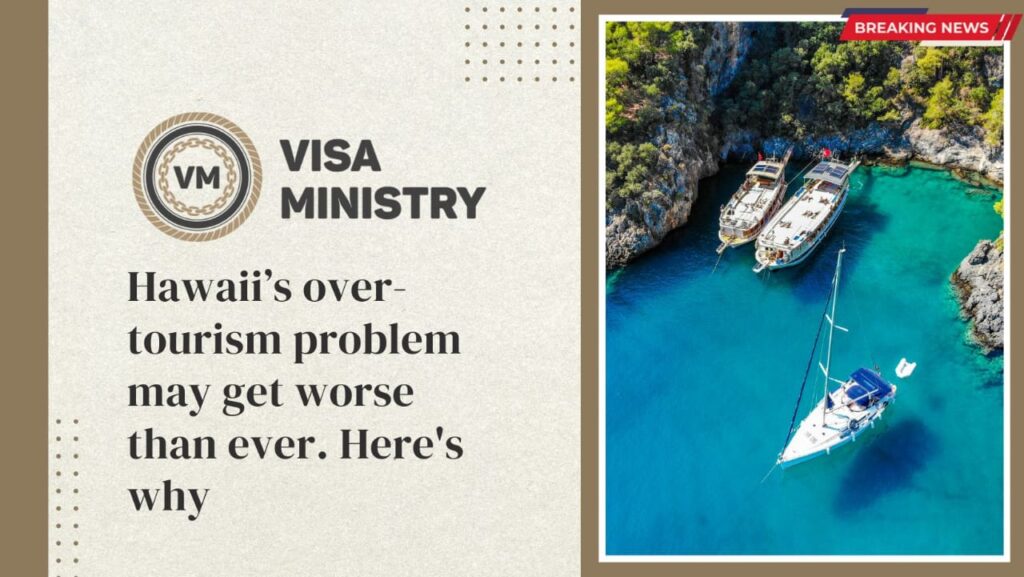The state’s tourist board is in danger of failing, along with its sensible regulations for controlling foot traffic to Hawaii’s most revered and stunning locations.
Early in 2021, Hawaii’s tourism board launched a ground-breaking initiative to integrate true Native Hawaiian culture into every aspect of its visitor economy, using it to improve the tourist experience while assisting in the protection of its people and sensitive areas. The “Malama Hawaii” or “Care for Hawaii” effort to promote sustainable tourism may be coming to an end after only three years.
Hawaii’s legislators have included no funding for the state’s 25-year-old tourism agency in the proposed state tourism budget bill for fiscal year 2023–2024, which begins on July 1. This is despite the fact that a busy summer tourist season is quickly approaching. Late in April, lawmakers examined two measures to dissolve the Hawaii Tourism Authority and replace it with a new organisation that would put more of an emphasis on resource management rather than attracting tourists to the state.
Although the bill was postponed and HTA is still in operation, many informed sources who talked with Bloomberg forecast that the agency’s exclusion from the final budget will severely hamper HTA’s ability to manage tourism on the islands.
The Hawaii Tourism Authority’s chief executive, John De Fries, stated in a newsletter that without financing, the HTA’s efforts in destination management, visitor education, and brand promotion will be at risk. He stated that the HTA will be “making tough decisions in the coming days” about the cancellation of current contracts and “ongoing community work.”
The tourist office can utilise $30 million in unused American Rescue Plan Act monies, which is half of the amount the HTA had asked for the upcoming fiscal year, according to legislators, to continue managing tourism.
All of this poses an existential danger to enhanced crowd control methods safeguarding the state’s most vulnerable locations as well as the cultural events, festivals, and community-led volunteer opportunities that have recently made Hawaii such a dynamic place to visit.
Vacationer tensions
Legislative squabbles with Hawaii’s tourist bureau are nothing new. With 10.4 million visitors each year, it reached a boiling point in 2019, when Hawaii’s 1.5 million citizens saw their home state turn into a case study in overtourism. The negative effects of that unregulated industry include trash clogging up popular tourist destinations, overcrowded beaches where it’s difficult to spread out a towel, coral reefs that are bleaching, traffic jams brought on by tourists taking selfies, and sacred sites being vandalised with graffiti and spray paint.
HTA was a victim of its own success in marketing the state to many Hawaiians both inside and outside of the government. And as a result, HTA started making significant changes to itself.
The agency’s objectives were refocused on making tourism more sustainable for everyone, replacing an executive leadership that was predominately made up of white people with one that was nearly entirely made up of Indigenous Hawaiians.
The “Malama Hawaii” initiative gained traction. In order to assist tourists become more aware of the vulnerability of Hawaii’s beautiful and holy locations, it disseminated responsible tourism messages to them before and during their journeys and produced sustainable experiences. Additionally, it assisted in spreading out foot traffic to lessen the negative effects of mass tourism.
The state is anticipated to collect a record $1 billion in hotel bed taxes in 2023 since the modifications helped draw in more wealthy, higher-spending tourists. These visitors, in turn, were pleased to participate in community-led educational events including cultural walks in Waikiki, beach clean-ups in Kauai, and tours of a chocolate farm.
That development was deemed to be too slow by some Hawaiian politicians. Since then, the government has restricted the tourist office’s spending authority, severed its direct connection to hotel taxes, and started demanding state approval for contracts and yearly budgets.
“The legislature didn’t think [the change] was going fast enough,” says Frank Haas, president of Marketing Management Inc. and consultant for the HTA’s 2020–25 strategy plan for sustainable tourism growth.
Some lawmakers have been determined to dissolve the HTA for at least five years, according to Mondy Jamshidi-Kent, a professor of travel management at the University of Hawaii at Manoa. These legislators made up their minds before De Fries could begin working on the issue.
She complains, “I’m disappointed to have learned that they don’t incorporate the last three years of statistically measured improvement,” contending that the present debates are more motivated by feelings than by facts. “Our democratic process is under disturbing threat from this.”
According to Jamshidi-Kent, some government officials may have seen this “new way of tourism,” which emphasises Hawaiian culture in corporate operations and adds levels of actual accountability, as a threat. “Why the legislature is trying to fix something that is working doesn’t make sense.”
Sustainability Seeds
HTA has advanced in a short amount of time in a demonstrable way. In a poll conducted in the fourth quarter of 2022, more than 25% of US mainland visitors to Hawaii said they had seen messages about “caring for and respecting Hawaii’s culture, people, and environment” both before and during their visit.
On the subject of sustainability, an increasing number of state parks now demand reservations; as of May 1, the 4,000-acre ‘ao Valley State Monument on Maui became the fourth state park to do so. Through HTA-funded experimental programmes operated by the Native Hawaiian Hospitality Association (NaHAA), in partnership with the nonprofit organisation Travel2change, the number of community-run volunteer opportunities for visitors has more than quadrupled, from 30 to roughly 70, in recent years.
According to Mlia Sanders, executive director of NaHAA, all of this improved perceptions of tourism among locals. Nearly half of the 1,949 Hawaii residents polled statewide in the autumn of 2022 said they thought tourism was being managed better than it had been. The percentage of respondents who said their own island was being run for tourists at the expense of residents did not change significantly.
What Follows?
People who support HTA’s liquidation favour the construction of an alternative sort of tourism office that would concentrate solely on sustainable tourism management, rather than marketing to visitors. It would cost money and require time to establish.
Programmes and experiences that are equally valuable to tourists and residents are at risk. These include HTA-sponsored occasions like the Big Island Chocolate Festival, the Hawaii Food & Wine Festival, and the Hawaii Book and Music Festival on Oahu, which honours Hawaiian culture and heritage through storytelling and music. By highlighting Hawaiian arts and culture, these events enrich the visitor experience and provide residents with substantial sources of income.
In the upcoming three to six months, many of these programmes will likely experience cuts if Governor Josh Greene does not veto the proposed state budget. According to Sanders of the Native Hawaiian Hospitality Association, “To take all that away is terrifying.” The reservation procedures and crowd management techniques used to curb overtourism in Hawaii’s most vulnerable and stunning areas would also be in danger.
According to tourist marketing veteran Haas, one answer would be to reevaluate the HTA’s position within the government and give it the capacity to collaborate with other organisations like the Department of Land and Natural Resources. There might not be enough backing for such a severe restructure.
Any future organization’s objective should include outreach, according to Sanders. Without it, she asks: “How do we attract the right kind of visitor—one who is willing to contribute and be a part of social change—while they are here?”
Likewise, Jamshidi-Kent. The difference between saying, “Hey, come to Hawaii, lay on the beach, have a Mai Tai,” and saying, “Hey, we would love for you to come, but remember this is our home,” is marketing, according to the speaker. You must maintain this location.
Source: hindustantimes

